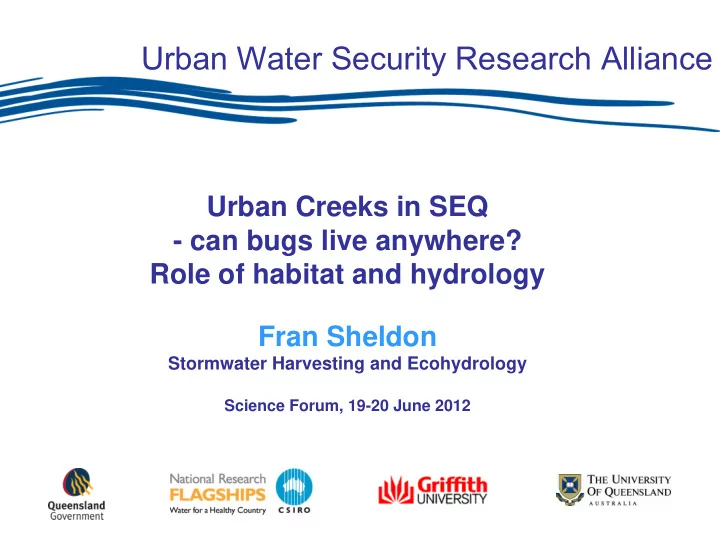

Urban Water Security Research Alliance Urban Creeks in SEQ - can bugs live anywhere? Role of habitat and hydrology Fran Sheldon Stormwater Harvesting and Ecohydrology Science Forum, 19-20 June 2012
CONCEPTUAL MODEL Urbanisation Changed hydrology (magnitude, frequency & duration) Habitat Availability & Water Quality Quality Invertebrate Diversity & Assemblage Composition
OUTLINE • Spatial analysis • Temporal analysis – preliminary results • Where to from now? Increasing %TIA Large number of sites over many streams Tributary to Stable Tingalpa Blunder Swamp Creek Creek Creek (forested) (WSUD) (urban)
SPATIAL ANALYSIS: EXPLORING ACROSS THE %TIA GRADIENT • Sites distributed across the %TIA gradient • Classified as: – Directly Connected (DC) – black triangles – Not Directly Connected (NDC) – open diamonds
METHODS Semi-Quantitative collections • 15 of the same sites as 2010 during baseflow conditions • both spring and autumn of 2007 & 2008 • 250- μ m-mesh dipnet used to collect benthic fauna from a total length of 10 m of habitat along the water’s edge, • Sampling and sorting followed EHMP protocols Quantitative collections • Quantitative samples collected from 16 sites across 12 different streams in May 2010 • Modified suction sampler used to collect samples by placing it over a defined bed area at 3 locations (individual riffles, or runs if riffles were not present) at each site.
RELATIONSHIPS BETWEEN MACROINVERTEBRATE DIVERSITY AND ENVIRONMENTAL VARIABLES EPT Taxa %TIA Richness DC directly connected to stormwater drainage NDC - not directly connected DO (mg/L)
INFLUENCE OF %TIA ON INDIVIDUAL TAXA May 2010 Threshold Indicator Taxa Analysis (TITAN) of macroinvertebrate assemblage response to the %TIA gradient 2007-2008
SPATIAL CONCLUSIONS • In the directly connected streams (DC), richness, relative richness and relative abundance of EPT taxa along with 2 macroinvertebrate sensitivity scores (SIGNAL2 and SPEARpesticides), were low when compared with streams without direct connection (NDC). • Results suggest urban streams in SEQ show similar responses to urban streams elsewhere – low richness of EPT and other sensitive taxa with increasing % of upstream impervious surfaces Leigh, C., Dunlop, J.E. and Sheldon, F. (in press). Generalist assemblages in urban streams lack association with the environmental conditions prevailing in their aquatic habitat during baseflow. Freshwater Science. Accepted May 2012.
WHAT DRIVES LOW DIVERSITY Urbanisation Increased rate of rise and fall Increased magnitude Changed hydrology Increased frequency (magnitude, frequency & duration) Reduced baseflows Increased siltation in pools Reduced DO under low flow Habitat Reduced habitat diversity in Increased turbidity Availability & Water Quality riffles (infilling by sand) pH and Salinity Quality Incised channels and lower Pesticides and Heavy metals habitat complexity Increased nutrients Reduced EPT and Sensitive Taxa Diversity
METHODS • Sites: – Tingalpa Creek (reference) – Stable Swamp Creek – Sunnybank, Keats Rd (urban) – Tributary to Blunder Creek – Daintree Close (WSUD) • Sampling – 3 ‘sites’ within each ‘reach’ – Replicate samples from specific habitats (riffles, pools, snags, macrophytes) 250 m sweep 10m of habitat – Macroinvertebrates – – Logged water quality and hydrology – Sampled every 6 weeks June 2011 – March 2012
SITES Tributary to Blunder Creek, Daintree Close (WSUD) Stable Swamp Creek – Sunnybank, Keats Rd (urban) Tingalpa Creek (reference)
SPECIES RICHNESS 35 WSUD Urban Forested 30 25 Mean Richness ± SE Richness (S) 20 Macrophyte/Snag Pool 15 Riffle 10 5 0 Blunder Tributary Stable Swamp Tingapla
ASSEMBLAGE DIFFERENCES: JUNE 2011 Multidimensional Scaling (MDS) Plot, Pray-Curtis Similarity Axis 2 Stable Swamp Pool habitats 1.0 Blunder Creek All habitats Blunder Creek Macrophyte Blunder Creek Pool WSUD Blunder Creek Riffle Stable Swamp Macrophyte 0.0 Stable Swamp Pool Urban Stable Swamp Riffle Tingalpa Pool Tingalpa Riffle Forested Stable Swamp Tingalpa Snag Riffle habitats -1.0 Tingalpa Riffle habitats 2D Stress: 0.09 Axis 1 -2 0 2 4
RELATIVE ASSEMBLAGE SIMILARITIES IN WINTER Urban Pools Urban Riffles Urban riffles more Forested similar in assemblage Riffles composition to forested riffles than urban pools
IF FLOW IS DRIVING REDUCED DIVERSITY EXPECT SHIFTS IN URBAN RIFFLE ASSEMBLAGES OVER SUMMER Winter Summer Urban Pools Urban Riffles Forested Riffles
IF HABITAT IS DRIVING REDUCED DIVERSITY EXPECT NO CHANGE IN URBAN RIFFLE ASSEMBLAGES OVER SUMMER Winter Summer Urban Pools Urban Riffles Forested Riffles
HABITAT MAPPING
SUMMARY • Riffle sites in urban streams more diverse that originally thought • Pool sites in urban streams extremely low diversity • If there were fewer riffles present in urban streams, compared with forested, then apparent low diversity could reflect reduced habitat availability • But, habitat availability appears to be similar – Habitat quality may differ • Next stage of study – Complete temporal analysis of assemblage change – Relate to water quality and hydrology data – Map riffle habitat “quality” across the %TIA gradient
ACKNOWLEDGEMENTS • Spatial Sampling – Jason Dunlop (DERM) – 2007-2008 collections – Catherine Leigh (ARI) – 2010 collections • Temporal Sampling Research Team – Michael Newham – Wendy Neilan – Carolyn Poulson – Janine Woods – Lars Pelzer
Urban Water Security Research Alliance THANK YOU www.urbanwateralliance.org.au
Recommend
More recommend